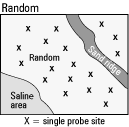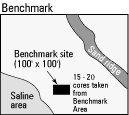| | Soil testing has become an important tool for assessing soil fertility and arriving at proper fertilizer recommendations. It's also a valuable management aid for studying soil changes resulting from cropping practices and for diagnosing specific cropping problems.
Soil testing provides an index for the nutrient availability in soil and is a critical step in nutrient management planning. Soil sampling technique, timing of sampling and type of analysis need to be considered for accurate results. The biggest problem in the effective use of soil testing is proper and representative sampling. Proper soil sampling will provide accurate soil test results and reliable nutrient recommendations.
The following information is offered to answer special questions concerning soil sampling. Further information and guidance can be obtained by contacting your fertilizer dealer, private laboratory or crop advisor.
When to sample
Cultivated fields for spring seeding should be sampled after October 1. These fields can also be sampled in the spring, but time may be limited then. Fields for fall-seeded crops should be sampled one month before seeding. Forage fields for seed, pasture or hay may be sampled after September 1. Problem soil areas may be sampled anytime. Frozen and water-logged soils should not be sampled because of the difficulty in obtaining a representative sample.
Where to sample
Soil variability is a major concern when deciding how to collect a representative soil sample. Soil samples submitted for analysis should be representative of the field or portion of a field. Therefore, by sampling from an area of the field where yield is typically average, soil test results should come back with an average representation of the field.
Identifying areas that are representative can be difficult without a first-hand knowledge of the field. If the person taking the soil samples does not take the time or have the knowledge required to take a sample in the appropriate location, the results can come back somewhat unrepresentative.
 |  |
Source: Westco Fertilizers
Random soil sampling is the traditional approach that works for uniform fields with little variation. The managed random sampling technique samples from areas identified as average production areas. This approach is different from random sampling, which provides an average of all cores taken throughout your field. Managed random sampling is recommended if you cannot identify a dominant production area on your field.
Benchmark sampling is recommended for fields with more variability (hills, pot holes, etc.). Benchmark sampling reduces the inherent variability of a field by reducing the area sampled. A small area (generally about ¬ of an acre) representing the majority of the field is sampled the same number of times as in random sampling. This is the reference area from which fertilizer recommendations are made.
The benchmark site should be marked with a global positioning system (GPS) or other means so that one can return there for subsequent years' sampling. Sampling from the same area will reduce sampling variability and create a better picture of year-to-year changes. Creating more than one benchmark is recommended if you cannot identify a dominant production area on your field.
In the first year, analyzing a few separate benchmark areas will reduce the risk of getting a sample not representative of the field. Although there are higher costs for laboratory analysis, this technique helps determine what area to use as a benchmark for future soil sampling.
When picking a benchmark area, use observable features such as soil color and landscape to identify where different soil types occur. Select a site that has characteristics similar to most of the field or the dominant soil type.
Often, the best time to identify different soil characteristics is through crop development. At the beginning of the growing season, differences in crop establishment and vigor can be seen, making a representative location easier to pick out. Other ways of selecting potential benchmark sites include the use productivity, yield, aerial and/or topographic maps.
The benchmark process can be further extended by establishing a couple of benchmark areas in different areas that allow customization of fertilizer rates. By identifying a primary benchmark area, and a secondary benchmark area and perhaps even a tertiary benchmark area, a fine-tuned fertility management strategy can be achieved even without variable rate technology.
Dividing a field into management zones allows for an understanding of different conditions within a field. This approach is particularly effective in rolling and hummocky landscapes. For example, a large depression may be a very productive area, but a separate soil test may indicate it can be optimized with a higher rate of nitrogen than the benchmark is indicating. While most producers do not have variable rate capabilities, rates can often be easily increased through other adjustments.
Each field (with the same crop and management history) must be sampled separately. Size up each field and observe variations in yield and crop growth, texture, color, slope, degree of erosion, drainage and past treatment. Sizable areas of fields where growth is significantly different from the rest of the field should be sampled separately.
Avoid unusual areas such as dead or back furrows, old straw, hay or manure piles, waterways, saline spots, eroded knolls and old fence rows. Select 15 to 20 sampling sites representative of the portion of the field to be tested.
Sample tools and methods
Representative soil samples can best be obtained by using a core sampling tool. The use of a proper sampling tool is essential for sampling to depths below 15 cm. Take soil cores from 0-15 cm at each of the 15 to 20 sampling sites. For improved nitrogen and sulfur evaluation or where problem soils are encountered, separate samples should be taken from the 0-15 cm, 15-30 cm, and 30-60 cm depths at the same 15 to 20 sites.
Place cores in clean pails or bags then mix cores taken from the same depths, crushing lumps in the process. Keep samples taken from individual depths separate from one another. Soil samplers may be available on request from fertilizer dealers, private labs or crop advisors. Many fertilizer dealers offer soil sampling services.
Preparing and submitting samples
How the soil is handled after sampling is just as important as collecting the soil sample. Remove half a kilogram, and air dry to stop nitrate build-up. To air dry, spread a thin layer of soil on a clean piece of paper, plastic sheets or clean, shallow containers (plastic, aluminum, etc.) in a clean room at room temperature. Do not dry with artificial heat. Some laboratories accept moist samples, but these samples must be delivered to the laboratory the same day as they are collected. Samples can also be stored in a refrigerator for a couple of days or frozen if sample delivery is delayed.
Contact your laboratory regarding packing and shipping instructions. Fill the sample containers (boxes, bags, etc.), and label each sample with your name, address, postal code, field and depth from which the sample was taken. Repeat these steps for each uniform field to be sampled. Provide complete information for each soil sample on the sheet supplied. Where unusual problems exist, these should be noted in detail. Keep a completed field plan of the area represented by each sample for your own records.
Laboratory analyses
Consult with your laboratory regarding laboratory analyses of agricultural soils. Research in Alberta indicates that the typical soil analyses package for surface (0-15 or 0-30 cm) agricultural soils should include soil tests for nitrate-nitrogen, available phosphorus, available potassium and extractable sulfur, plus soil pH and salinity (electrical conductivity). If possible, the nitrate and sulfur analysis should be completed for subsurface soil samples (15-30 and 30-60 cm). Additional analyses for micronutrients (Boron, Chlorine, Copper, Iron, Manganese or Zinc), or organic matter for the surface soil samples may be requested. Some laboratories may provide additional analyses as part of the routine analyses package that they may use to improve interpretations and recommendations. |
|